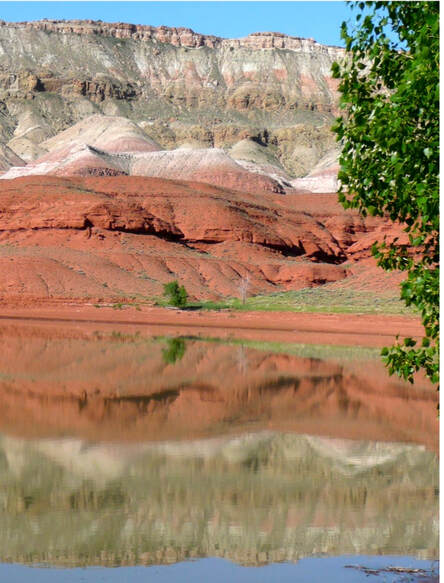Angular Unconformity C Between layers that are parallel to each. Nonconformity A Between strata not parallel to each other 2.
Which Principle Tells You How Rock Layers Are Laid Quora
Geologists are able to read the rock layers using relative and absolute dating techniques.
. Accordingly the oldest rocks in a sequence are at the bottom and. A Younger Sediment or Rock Can Contain Pieces of an Older Rock. Principle of Original Horizontality.
This understanding helps geologists determine the history of rocks on Earth and contribute evidence of the geological time scale of the history of Earth. Catholic priest Nicholas Steno established the theoretical basis for stratigraphy when he introduced the law of superposition the principle of original horizontality. Access the answers to hundreds of Sedimentary rock questions that.
This Law of Superposition is fundamental to the interpretation of Earth history because at any one location it indicates the relative ages of rock layers and the fossils in them. This means that all the rock layers were laid horizontally. Layered rocks form when particles settle from water or air.
Another important principle is the principle of original horizontality. The principle of superposition states that in an undeformed sequence of sedimentary rocks each layer of rock is older than the one above it and younger than the one below it Figures 1 and 2. Most sedimentary rocks are laid down in flat horizontal layers.
Principle of Crosscutting Relationships. Sedimentary and volcanic rocks are laid down in nearly horizontal layers. There are several basic principles that geologists use to figure out the history of a rock.
In geology this is referred to as the principle of superposition meaning rocks on the top are generally younger than rocks below them. If one rock unit. It was first described by Nicolaus Steno and is well illustrated in the diagram here.
Sedimentary layers are laid down parallel to the earths surface. Get help with your Sedimentary rock homework. Principle of Lateral Continuity.
When a rock or deposit forms it can contain pieces or clasts of older rock layers. Chances are these rocks are sedimentary since they. The law of superposition states that rock strata layers farthest from the ground surface are the oldest formed first and rock strata layers closest to the ground surface are the youngest formed most recently.
Sedimentary Rock Questions and Answers. ____ The Principle of Superposition ____ tells us that older layers of rock occur below younger layers of rock. The Law of Superposition is an essential principle in geology where older rocks and rock layers are formed first and are beneath younger rocks and rock layers.
Sedimentary and volcanic rocks are laid down in layers that are usually much greater in lateral extent than in thickness. The law of superposition states that layers of undeformed moved or changed sedimentary rock are deposited so that each layer is younger than the layers below it and older than the layers above it. A large gap in age between rocks with one on top and another underneath.
If you take a look at a cliff you might notice different layers of rocks. So we are talking about stratigraphy from the Greek meaning writing graph of layers strata. Genesis geology and logic remind us that Noahs Flood definitely would have made water-laid rock layers just like we see today.
For example in a fast-moving river the granite bedrock in the riverbed is exposed to a lot of physical weathering from the current and pieces of it break off when other rocks hit it. The principle of uniformitarianism states that processes that alter the earths crust are the same processes that occurred millions of years ago. Relative dating arranges geological events and the rocks they leave behind in a sequence.
The scientific principle which states that younger rock layers are generally deposited on top of older rock layers is known as Angular Unconformity and occurs due to the Law of superposition. These can later tilt and fold due to tectonic activity and river cuttings can cause gaps among the layers. Principle of Lateral Continuity.
Deposition of sediment rocks are uplifted and eroded erosion of strata new rock is laid down on top of older rock and finally uplift and erosion expose the unconformity at the surface. In sedimentary layers rocks are layered with the youngest on top and the oldest on the bottom. Older layers are laid down first with younger layers on top Law of Original Horizontality In undisturbed rock layers sedimentary rocks are generally laid down in horizontal layers.
Match each unconformity to its definition. Disconformity B Between igneous and sedimentary rocks 3. There is one final principle of relative dating that you need to learn about and then you will get a chance to put your skills to the test and assign relative ages to some sample rock strata.
Principle of Original Horizontality. This final principle is called the principle of later continuity. Which principle tells you how rock layers are laid.
So the next time you see all those layers at the Grand Canyon or your local road cut remember that Genesis describes water rising for months surging back and forth then falling for more monthseroding and.

Which Principle Tells You How Rock Layers Are Laid Brainly Com
Which Principle Tells You How Rock Layers Are Laid Quora

Laws Of Horizontality Superposition Maggie S Science Connection
0 Comments